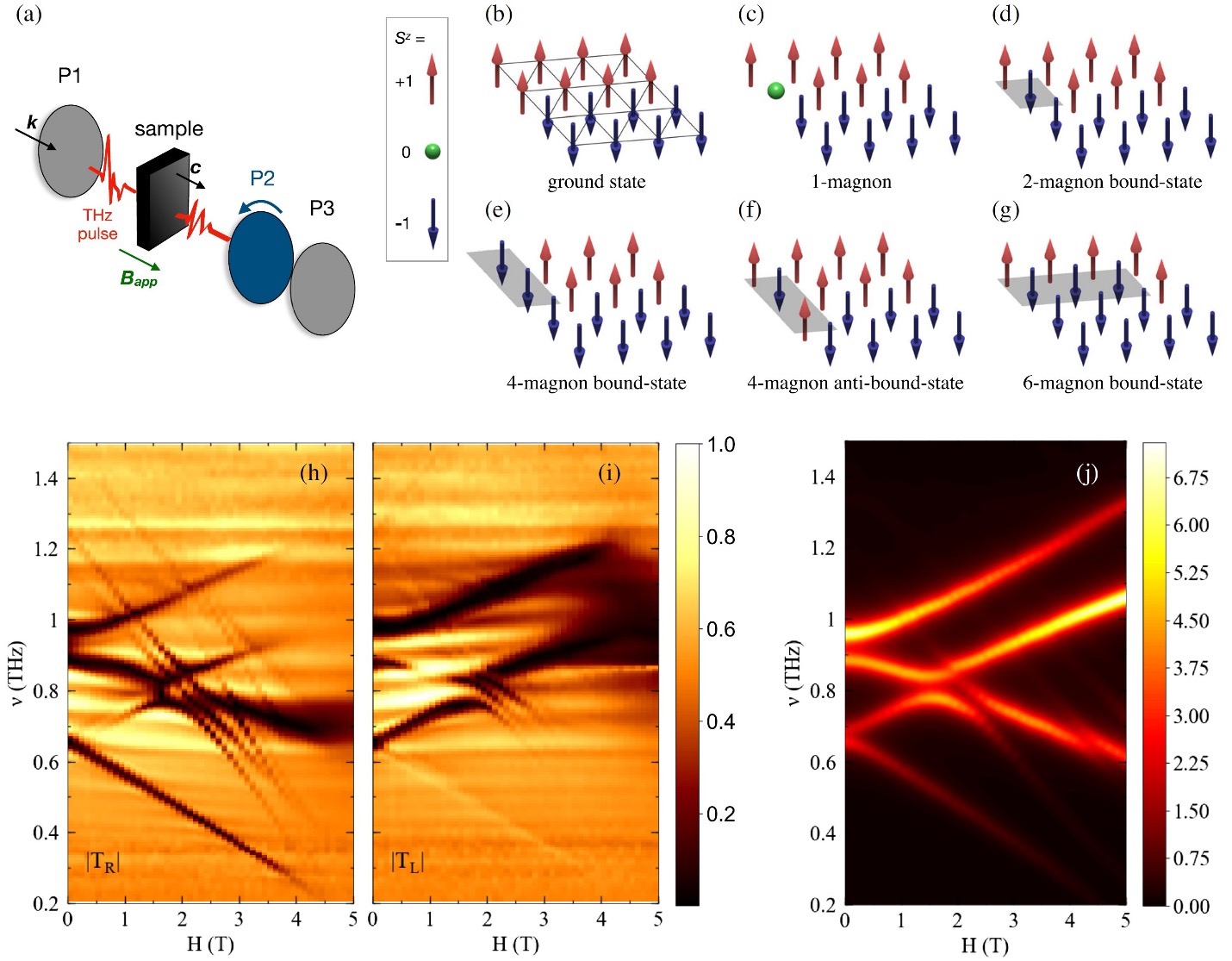PARADIM Highlight #61—External User Project (2022)
Martin Mourigal (Georgia Tech), N. Peter Armitage (Johns Hopkins)
Magnons, or spin waves, are quasiparticles describing collective spin excitations of ordered magnets. When magnon-magnon interactions are strong, new multi-magnon excitations and bound states can emerge. Here, magnetic THz spectroscopy of the layered magnet FeI2 revealed a complex series of excitations beyond the one-magnon picture.

Figure 1: (a) Sketch of the experimental time-domain terahertz spectroscopy setup. A dc magnetic field is applied along the sample’s c axis in the Faraday geometry (parallel to the THz propagation). (b)-(g) Single-ion states of Fe2+ ions accessible at low energy correspond to S = 1 magnetic moments with uniaxial anisotropy. The sketches represent a plane of spins in the (b) ground state configuration, and examples of (c) a one-magnon elementary excitation (spin wave), (d) a two-magnon bound state (SIBS), (e) a 4-magnon bound state, (f) a 4-magnon antibound state, and (g) a 6-magnon bound state. The gray shadows represent the particular spins that are deviated as compared to the ground state. (h)-(i) Magnitude of the transmission coefficients for (h) right- and (i) left-handed circularly polarized lights (normalized to 1), at T = 4 K, as a function of frequency and magnetic field (horizontal striations are experimental artifacts). (j) Calculated ω[χ′′xx(q=0,ω)+χ′′yy(q=0,ω)] as a function of energy (or associated frequency) and magnetic field.
These 4- and 6- magnon bound states emerge due to strong hybridization of individual states and thus represent discovery of new and novel type of magnetic excitation. This demonstrates the utility of THz spectroscopy in probing magnetic ground states and demonstrates that layered magnets are a route to novel (and potentially useful) forms of quantum magnetism. It also provides a unique platform to study decay and renormalization, reminiscent of the few-body problems found in cold-atom, nuclear, and particle physics.
Large single crystals were grown at PARADIM’s Bulk Crystal Growth Facility by an external user (Mourigal), and then distributed to their collaborator (Armitage) with theory collaborations to interpret the results (Batista).
We observe a wealth of multimagnon bound states in the strongly anisotropic spin-1 triangular antiferromagnet FeI2 using time-domain terahertz spectroscopy. These unconventional excitations can arise in ordered magnets due to attractive magnon-magnon interactions and alter their properties. We analyze the energy-magnetic field spectrum via an exact diagonalization method for a dilute gas of interacting magnons and detect up to 4- and 6-magnon bound states, hybridized with single magnons. This zoo of tunable interacting quasiparticles provides a unique platform to study decay and renormalization, reminiscent of the few-body problems found in cold-atom, nuclear, and particle physics.
Quantum magnets are leading candidates for use in next generation quantum technologies. Mapping the universe of novel excitations is essential to understanding and harnessing them. In classic models of magnetic excitations, individual quasiparticles representing those excitations (such as magnons) are assumed to be nearly free and interact only very weakly. However, if magnon-magnon interactions are strong, new and distinct quasiparticles formed from multi-magnon bound states can emerge. Here, magnetic THz spectroscopy of the layered magnet FeI2 revealed a complex series of excitations beyond the one-magnon picture that emerge due to strong hybridization of individual states and thus represent discovery of new and novel type of magnetic excitation. This demonstrates the utility of THz spectroscopy in probing magnetic ground states and demonstrates that layered magnets are a route to novel (and potentially useful) forms of quantum magnetism.
Multi-cm scale single crystals of layered materials are usually difficult to grow due to the strong crystal anisotropy. Here, PARADIM’s mid-sized induction furnace enabled a sufficiently controlled and large temperature gradient to successfully produce single crystals by a Bridgman technique limited only by the size of the container.
The work was conceived and performed by scientists from Georgia Tech through a PARADIM User Proposal with additional contributions from Oak Ridge National Lab and Johns Hopkins University.
A. Legros, S.-S. Zhang, X. Bai, H. Zhang, Z. Dun, W.A. Phelan, C.D. Batista, M. Mourigal, and N.P. Armitage, "Observation of 4- and 6-Magnon bound-States in the Spin-Anisotropic Frustrated Antiferromagnet FeI2," Phys. Rev. Lett. 127, 267201 (2022) DOI: https://doi.org/10.1103/PhysRevLett.127.267201.
Work at JHU (A. L, N. P. A.) was supported as part of the Institute for Quantum Matter, an EFRC funded by the DOE BES under DE-SC0019331. A. L. and N. P. A thank Howard Katz and Jinfeng Han from the Department of Materials Science and Engineering at JHU for providing the necessary equipment to prepare the sample for measurements. The work at GT (X. B., Z. L.D., M.M.) and the University of Tennessee (S.-S. Z., H. Z., C. D. B.) was supported by the DOE BES under Award No. DE-SC-0018660. The work by H. Z. was supported by the Graduate Advancement, Training and Education (GATE) program of UTK and ORNL. Growth of FeI2 crystals is based upon work supported by the National Science Foundation [Platform for the Accelerated Realization, Analysis, and Discovery of Interface Materials (PARADIM)] under Cooperative Agreement No. DMR-1539918.







